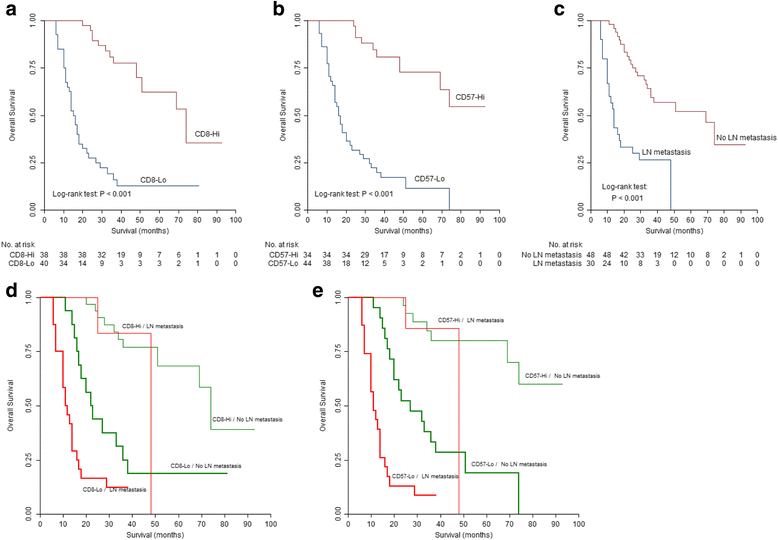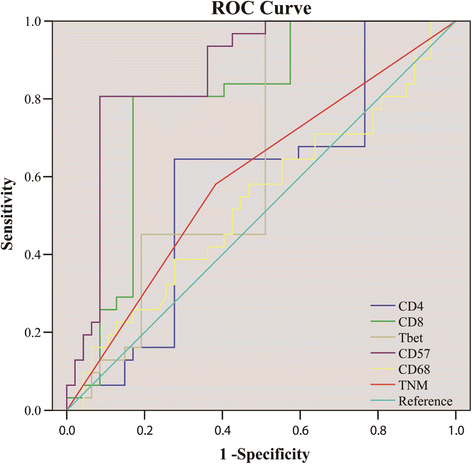Prognostic significance of tumor infiltrating immune cells in oral squamous cell carcinoma
- PMID: 28549420
- PMCID: PMC5446725
- DOI: 10.1186/s12885-017-3317-2
Prognostic significance of tumor infiltrating immune cells in oral squamous cell carcinoma
Abstract
Background: Prognostic factors aid in the stratification and treatment of cancer. This study evaluated prognostic importance of tumor infiltrating immune cell in patients with oral squamous cell carcinoma.
Methods: Profiles of infiltrating immune cells and clinicopathological data were available for 78 OSCC patients with a median follow-up of 48 months. The infiltrating intensity of CD8, CD4, T-bet, CD68 and CD57 positive cells were assessed by immunohistochemistry. Chi-square test was used to compare immune markers expression and clinicopathological parameters. Univariate and multivariate COX proportional hazard models were used to assess the prognostic discriminator power of immune cells. The predictive potential of immune cells for survival of OSCC patients was determined using ROC and AUC.
Results: The mean value of CD8, CD4, T-bet, CD68 and CD57 expression were 28.99, 62.06, 8.97, 21.25 and 15.75 cells per high-power field respectively. The patient cohort was separated into low and high expression groups by the mean value. Higher CD8 expression was associated with no regional lymph node metastasis (p = 0.033). Patients with more abundant stroma CD57+ cells showed no metastasis into regional lymph node (p = 0.005), and early clinical stage (p = 0.016). The univariate COX regression analyses showed that no lymph node involvement (p < 0.001), early clinical stage (TNM staging I/II vs III/IV, p = 0.007), higher CD8 and CD57 expression (p < 0.001) were all positively correlated with longer overall survival. Multivariate COX regression analysis showed that no lymph node involvement (p = 0.008), higher CD8 (p = 0.03) and CD57 (p < 0.001) expression could be independent prognostic indicators of better survival. None of CD4, T-bet or CD68 was associated with survival in ether univariate or multivariate analysis. ROC and AUC showed that the predictive accuracy of CD8 and CD57 were all superior compared with TNM staging. CD57 (AUC = 0.868; 95% CI, 0.785-0.950) and CD8 (AUC = 0.784; 95% CI, 0.680-0.889) both provided high predictive accuracy, of which, CD57 was the best predictor.
Conclusion: Tumor stroma CD57 and CD8 expression was associated with lymphnode status and independently predicts survival of OSCC patients. Our results suggest an active immune microenvironment in OSCC that may be targetable by immune drugs.
Keywords: Oral squamous cell carcinoma (OSCC); Overall survival (OS); Prognosis; Tumor infiltrating immune cell.
Figures



References
MeSH terms
LinkOut - more resources
Full Text Sources
Other Literature Sources
Medical
Research Materials

